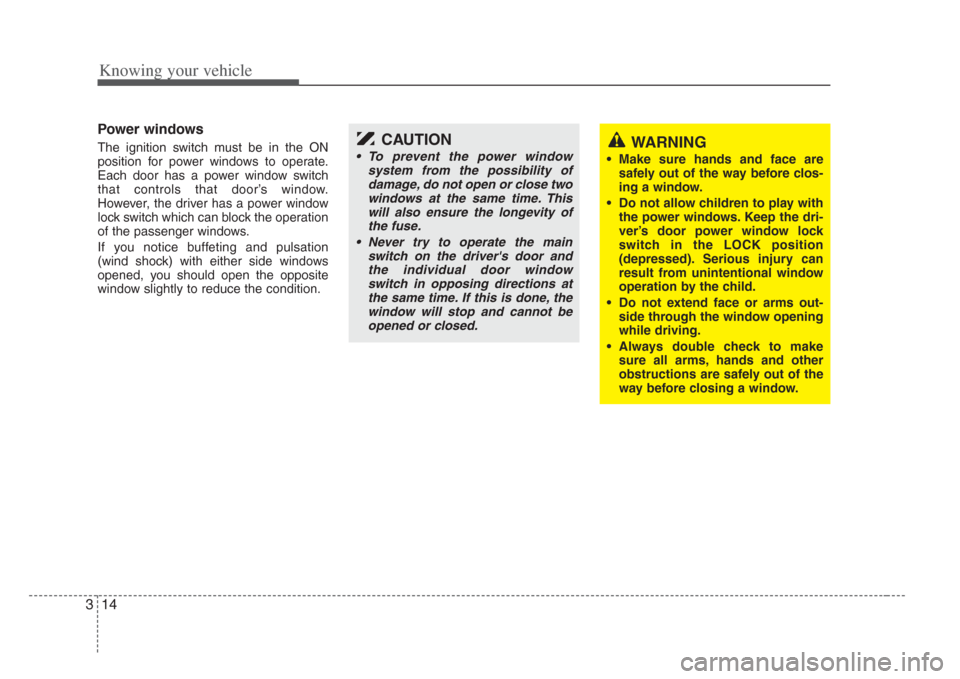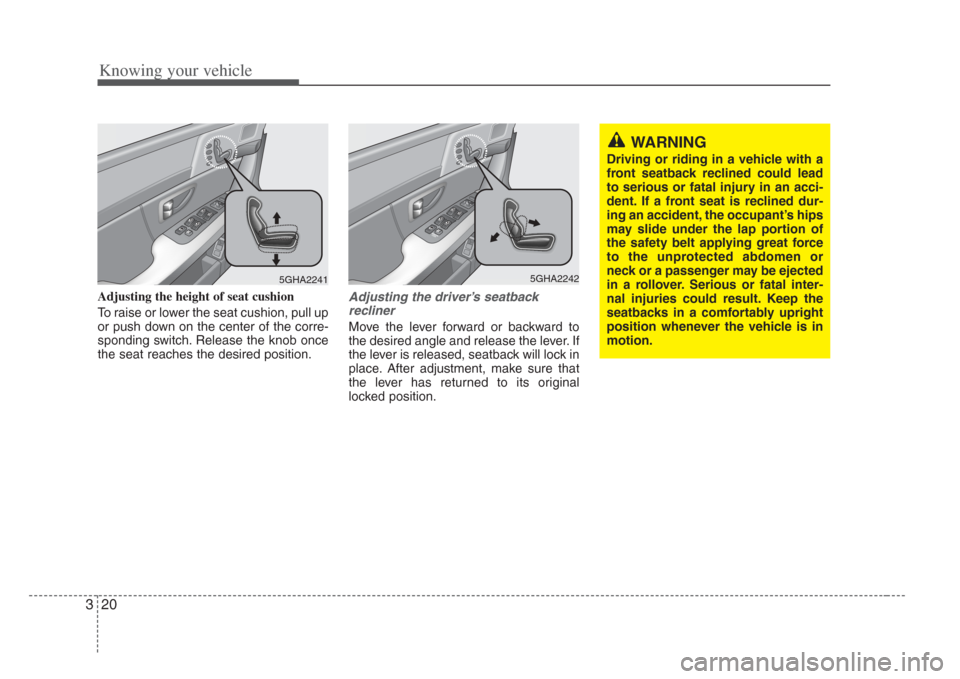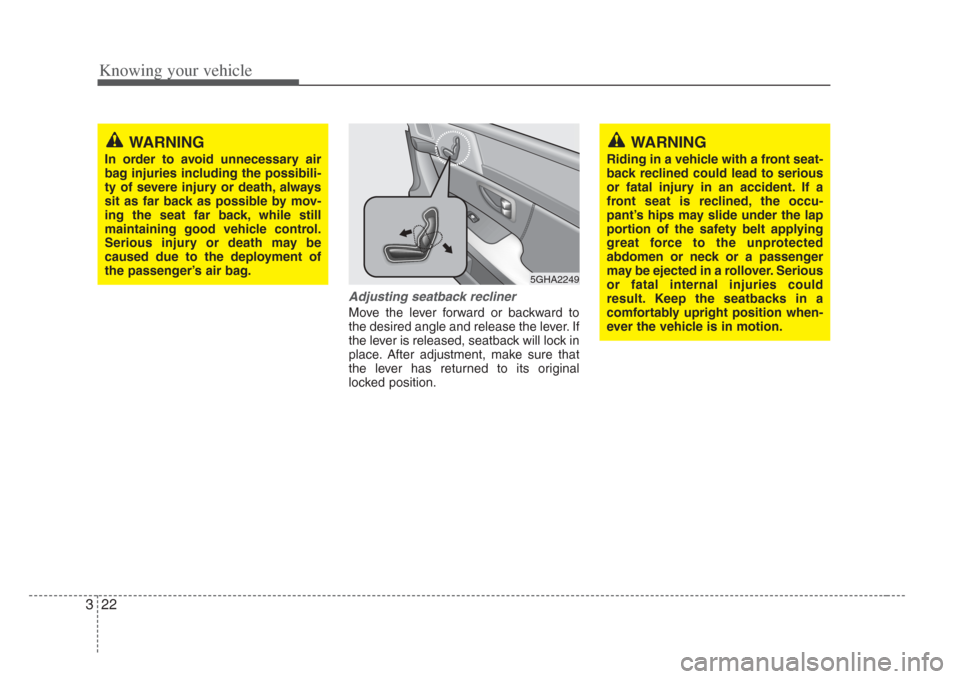Page 24 of 283

Knowing your vehicle
143
Power windows
The ignition switch must be in the ON
position for power windows to operate.
Each door has a power window switch
that controls that door’s window.
However, the driver has a power window
lock switch which can block the operation
of the passenger windows.
If you notice buffeting and pulsation
(wind shock) with either side windows
opened, you should open the opposite
window slightly to reduce the condition.CAUTION
• To prevent the power windowsystem from the possibility of
damage, do not open or close two windows at the same time. Thi s
will also ensure the longevity of the fuse.
• Never try to operate the main switch on the driver' s door and
the individual door window s witch in opposing directions at
the same time. If this i s done, the
window will stop and cannot be opened or closed.
WARNING
• Make sure hands and face are
safely out of the way before clo s-
ing a window.
• Do not allow children to play with the power window s. Keep the dri-
ver’ s door power window lock
s witch in the LOCK pos ition
(depressed). Serious injury can
result from unintentional window
operation by the child.
• Do not extend face or arm s out-
side through the window opening
while driving.
•Alway s double check to make
sure all arms, hands and other
obstructions are safely out of the
way before closing a window.
Page 26 of 283

Knowing your vehicle
163
Power window lock switch
• The driver can disable the power win-
dow switches on a passenger door by
depressing the power window lock
switch located on the driver’s door to
LOCK (pressed).
• When the power window lock switch is ON, the driver’s master control cannot
operate the passenger door power
windows either.
Power window timer (if equipped)
The power windows can be operated for
approximately 30 seconds after the igni-
tion key is removed or turned to the ACC
or LOCK position. However, if the front
doors are opened, the power windows
cannot be operated even within 30 sec-
onds after the ignition key is removed.
WARNING
• The automatic window rever sal
feature (window lower s 150 mm
[5.9 inches] when a resistance is
detected) will only operate when
the automatic power window up
operation feature is used.
Automatic window rever sal will
not operate if the window is
raised using the fir st detent posi-
tion (
➄) on the power window
s witch. Always double check to
make sure all faces, arms, hands
and other obstructions are safely
out of the way before operating
the power window.
• If an object less than 4 mm (0.16 inch) in diameter is caught
between the window gla ss and
the upper window channel, the
automatic rever sal may not detect
the resistance and will not oper-
ate. Therefore, always check for
any obstructions before raising
any window.
Page 28 of 283

Knowing your vehicle
183
For a seating position more comfortable
to the driver and front passenger, adjust
the seat forward, backward, up and
down.
WARNING
• Loose objects in the driver’s foot
area could interfere with the oper-
ation of the foot pedal s,possibly
caus ing an accident. Loos e
objects might interfere with the
s eat slide mechanis m. Do not
place anything under the front
seats.
• The power s eats are operable
with the ignition OFF.
Therefore, children should never
be left unattended in the car.
WARNING- Driver’ s seat
• Never attempt to adjus t the seat
while the vehicle is moving. This
could res ult in loss of control, and
an accident caus ing death,seri-
ous injury, or property damage.
• Do not allow anything to interfere with the normal pos ition of the
s eatback. Storing items against a
s eatback or in any other way inter-
fering with proper locking of a
s eatback could res ult in serious
or fatal injury in a s udden stop or
collis ion.
(Continued)
(Continued)
• Always drive and ride with yourseatback upright and the lap por-
tion of the safety belt, or lap belt,
snug and low across the hips.
This pos ition puts your safety
belts in the best position to pro-
tect you in case of an accident.
• In order to avoid unnece ssary air
bag injuries including the po ssi-
bility of severe injury or death,
always sit as far back as possible
from the steering wheel while still
being able to maintain comfort-
able control of your vehicle.
• The Canadian Motor Vehicle Safety Standards (CMVSS) rec-
ommends that the driver sit at
least 250 mm (10 inches) away
from the steering wheel to avoid
the risk of serious injury or death
due to the deployment of the dri-
ver’ s air bag.
CAUTION
• Power seats are driven by electric
motor. Stop operating when the adjustment is completed.
Excessive operation may damagethe electrical equipment.
• When in operation, the power seats consume large amounts ofelectrical power. To preventunnecessary charging s ystem
drain, don’t adjus t the power
s eats longer than necessary
while the engine is not running.
• Do not operate two or more power seat control buttons at the sametime. Doing so may res ult in
power seat motor or electrical
component malfunction.
Page 30 of 283

Knowing your vehicle
203
WARNING
Driving or riding in a vehicle with a
front seatback reclined could lead
to serious or fatal injury in an acci-
dent. If a front seat is reclined dur-
ing an accident, the occupant’ s hips
may slide under the lap portion of
the safety belt applying great force
to the unprotected abdomen or
neck or a passenger may be ejected
in a rollover. Serious or fatal inter-
nal injuries could result. Keep the
seatbacks in a comfortably upright
position whenever the vehicle i s in
motion.
Adjusting the height of seat cushion
To raise or lower the seat cushion, pull up
or push down on the center of the corre-
sponding switch. Release the knob once
the seat reaches the desired position.Adjusting the driver’ s seatback
recliner
Move the lever forward or backward to
the desired angle and release the lever. If
the lever is released, seatback will lock in
place. After adjustment, make sure that
the lever has returned to its original
locked position.
5GHA22415GHA2242
Page 32 of 283

Knowing your vehicle
223
Adjusting seatback recliner
Move the lever forward or backward to
the desired angle and release the lever. If
the lever is released, seatback will lock in
place. After adjustment, make sure that
the lever has returned to its original
locked position.
WARNING
In order to avoid unnecessary air
bag injuries including the po ssibili-
ty of severe injury or death, alway s
sit as far back as possible by mov-
ing the seat far back, while still
maintaining good vehicle control.
Serious injury or death may be
caused due to the deployment of
the passenger’ s air bag.
5GHA2249
WARNING
Riding in a vehicle with a front seat-
back reclined could lead to serious
or fatal injury in an accident. If a
front seat is reclined, the occu-
pant’ s hips may slide under the lap
portion of the safety belt applying
great force to the unprotected
abdomen or neck or a passenger
may be ejected in a rollover. Serious
or fatal internal injuries could
res ult. Keep the s eatbacks in a
comfortably upright po sition when-
ever the vehicle i s in motion.
Page 34 of 283

Knowing your vehicle
243
Headrest adjustment
Adjusting forward and backward
The headrest may be adjusted forward to
three different positions by pulling the
headrest forward. To adjust the headrest
backward, pull it fully forward to the far-
thest position and release it. Adjust the
headrest so that it properly supports the
head and neck.
Adjusting the height up and down
The headrest not only provides comfort
for the driver and passengers, but also
helps protect the head and neck in the
event of a collision.
To raise the headrest, pull it up to the
desired position (
➀). To lower the head-
rest, push and hold the release button
(
➁) on the headrest support and lower
the headrest to the desired position (
➂).
For best protection, adjust the headrest
so its center is as high as your ears. Also
adjust the headrest so its distance from
the head is as wide as your fist.
1GHA2245
WARNING
Pa ssenger s should us e extreme
caution when using seat warmers
due to the possibility of excess
heating or burn s. In particular, the
following types of passengers
should exercise extreme care:
1. Infants, children, elderly or di s-
abled per sons, or hospital outpa-
tients
2. Per sons with sensitive skin or
those that burn ea sily
3. Fatigued individual s
4. Intoxicated individual s
5. Individuals taking medication
that can caus e drowsiness or
sleepiness ( sleeping pills, cold
tablets, etc.)
1GHA2246
Page 35 of 283

325
Knowing your vehicle
Removal
To remove the headrest, raise it as far as
it can go then press the release button
(
➀) while pulling upward (➁).
Rear seat
Armrest
The armrest is located in the center of
the rear seat. Pull the armrest down from
the seatback.
You will find a storage cover and cup
holders (if equipped).
Warming the rear passenger seats
(if equipped)
Rear seats can be electrically heated
when the ignition switch is ON.
1. Pull the armrest down using the strap provided on the armrest.
2. When the switch is ON, a number ranging from 1 to 5 is displayed on the
switch (5 = warmest setting).
To turn off the seat warmer, set the
switch to 0.
The seat warmer turns off automatically
when the seat temperature reaches the
selected range and will turn on again if
the temperature drops below the select-
ed range.
WARNING
To reduce the ri sk of head and neck
injuries, do not drive the vehicle
with the headres t removed or
improperly positioned.
Do not adju st the driver’ s headrest
while driving.
1GHA2247OGH026090NOGH036320N
left rear seat
right rear seat
Page 36 of 283

Knowing your vehicle
263
Headrest adjustment
Adjusting the height up and down
The headrest not only provides comfort
for the rear passengers, but also helps
protect the head and neck in the event of
a collision.
For best protection, adjust the headrest
so its center is as high as your ears. Also
adjust the headrest so its distance from
the head is as wide as your fist.
To raise the headrest, pull it up to the
desired position (
➀). To lower the head-
rest, push and hold the release button
(
➁) on the headrest support and lower
the headrest to the desired position (
➂).
WARNING
Pa ssenger s should us e extreme
caution when using seat warmers
due to the possibility of excess
heating or burn s. In particular, the
following types of passengers
should exercise extreme care:
1. Infants, children, elderly or di s-
abled per sons, or hospital outpa-
tients
2. Per sons with sensitive skin or
those that burn ea sily
3. Fatigued individual s
4. Intoxicated individual s
5. Individuals taking medication
that can caus e drowsiness or
sleepiness ( sleeping pills, cold
tablets, etc.)
1GHA2254
CAUTION
• When cleaning the seats, do not
use an organic solvent such as
thinner, benzene, alcohol and gasoline. Doing so may damage
the surface of the heater or seats.
• To prevent overheating the seat
warmer, do not place blanket s,
cushions or seat cover s on the
seats while the seat warmer is in operation.
• Do not place heavy or s harp
objects on seats equipped with seat warmer s. Damage to the
seat warming components could occur.